“For a few weeks every year, Cano Cristales a small river flowing through the Sierra de la Macarena in Columbia’s province of Meta, dons an dazzling array of colors. By attracting Colombian tourists, the artist responsible for this unique phenomenon, an endemic aquatic plant, gives life and hope to populations of this area which has been controlled for nearly 40 years by the Colombian Revolutionary Armed Forces and coca production.
“El rio mas bonito del Mundo”, the most beautiful river of the world, the “River of five colors”, the “Rainbow River”, or even the “Escaped from Paradise”, are the shimmering appellations that Colombians give to Cano Cristales, a small stream located in the heart of the Macarena National Park, 150 km (93 miles) south of Bogota.
During the greater part of the year, Cano Cristales is a small stream jumping down and swirling in beautiful giant rocky pots, due to the fast flooding and draining typical of these tropical regions. At the end of the rainy season the river flow decreases. This is the time that the river is transformed to a festival of colors. From the end of July, while the level of water finally drops, Macarena clavigera, an endemic aquatic plant in the Macarena Sierra, finds the perfect conditions for its survival in the river. Fermly hanging on the dark rocks, it deploys a thick pink fuchsia hair, along an amber and strongly mineralized stream with yellow sand, between green reflections of trees and the sky's azure touches.
The Sierra de la Macarena National Park was created in 1971 to protect this important biological and geological region. But this biogeographical crossroads, where plant and animal species of the plateau of the Guianas, Amazonia and Orinoco basin concentrate, was then closed for many years during the occupation of the region by the Colombia Revolutionary Armed Forces (FARC). Due to the increase of security, the national park was re-opened 4 years ago and now hosts more than 3000, mostly Colombian visitors per year.
The new tourist boom in this naturally isolated area, formerly controlled by the FARCS for 40 years and where the guerrillas raged, is welcomed. Between the eco-guides, pirogues drivers and derived jobs, Cano Cristales and its colors help nearly 300 families that once depended on farming and coca to live. The national park generally closes its doors in November in order to preserve the Macarena clavigera reproduction that will dons an dazzling array of colors next July to the river known as the “Escaped from Paradise”. – Bernadette Gilbertas
“El rio mas bonito del Mundo”, the most beautiful river of the world, the “River of five colors”, the “Rainbow River”, or even the “Escaped from Paradise”, are the shimmering appellations that Colombians give to Cano Cristales, a small stream located in the heart of the Macarena National Park, 150 km (93 miles) south of Bogota.
During the greater part of the year, Cano Cristales is a small stream jumping down and swirling in beautiful giant rocky pots, due to the fast flooding and draining typical of these tropical regions. At the end of the rainy season the river flow decreases. This is the time that the river is transformed to a festival of colors. From the end of July, while the level of water finally drops, Macarena clavigera, an endemic aquatic plant in the Macarena Sierra, finds the perfect conditions for its survival in the river. Fermly hanging on the dark rocks, it deploys a thick pink fuchsia hair, along an amber and strongly mineralized stream with yellow sand, between green reflections of trees and the sky's azure touches.
The Sierra de la Macarena National Park was created in 1971 to protect this important biological and geological region. But this biogeographical crossroads, where plant and animal species of the plateau of the Guianas, Amazonia and Orinoco basin concentrate, was then closed for many years during the occupation of the region by the Colombia Revolutionary Armed Forces (FARC). Due to the increase of security, the national park was re-opened 4 years ago and now hosts more than 3000, mostly Colombian visitors per year.
The new tourist boom in this naturally isolated area, formerly controlled by the FARCS for 40 years and where the guerrillas raged, is welcomed. Between the eco-guides, pirogues drivers and derived jobs, Cano Cristales and its colors help nearly 300 families that once depended on farming and coca to live. The national park generally closes its doors in November in order to preserve the Macarena clavigera reproduction that will dons an dazzling array of colors next July to the river known as the “Escaped from Paradise”. – Bernadette Gilbertas
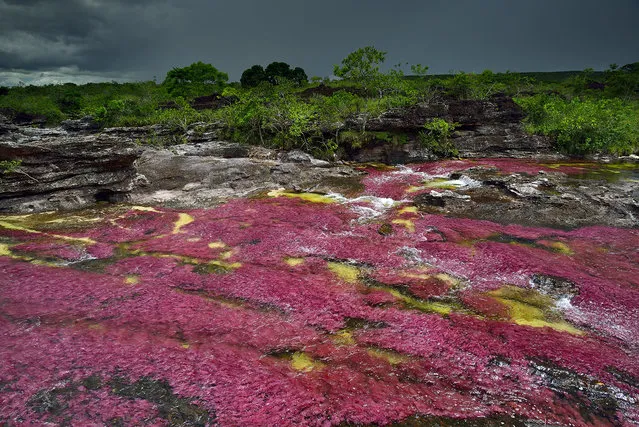
At the end of the rainy season, in August, when the water level finally decreases the Cano Cristales RIver in the Sierra de la Macarena in Colombia, becomes covered with a bright pink endemic aquatic plant, Macarenia Clavigera. (Photo by Olivier Grunewald)
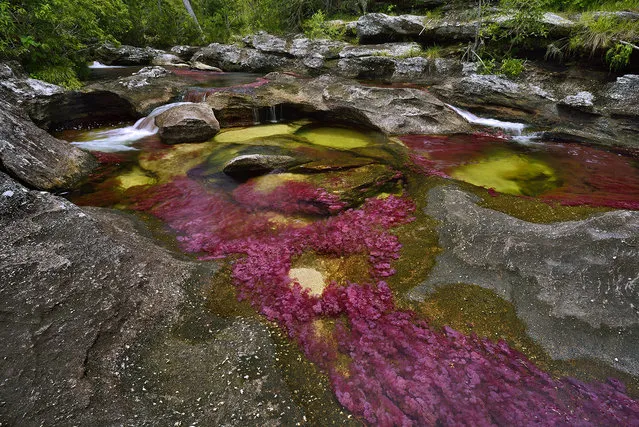
Cano Cristales is the “River of Five Colors” when aquatic plants that grow in its waters become red and when the Sun plays with water, yellow sand, and blue sky. (Photo by Olivier Grunewald)
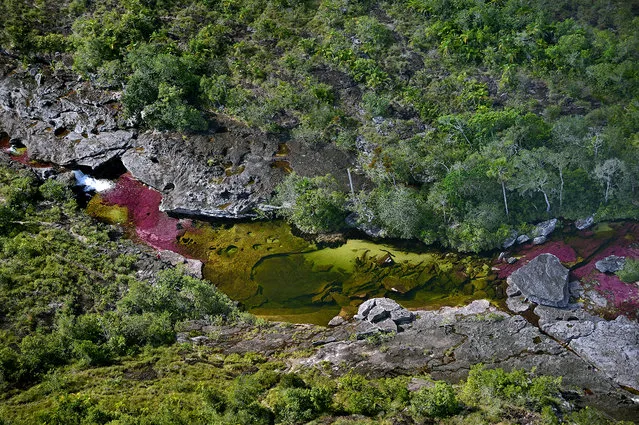
An overhead view of the Cano Cristales RIver in the Sierra de la Macarena in Colombia. (Photo by Olivier Grunewald)
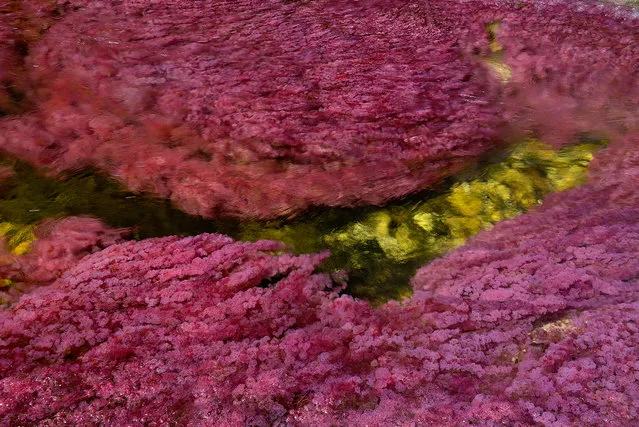
Macarenia clavigera the endemic aquatic plant that grows in the Cano Cristales RIver in Colombia becomes red when the water level drops, and when the current is not too strong. These pigments protect it from solar radiation. (Photo by Olivier Grunewald)
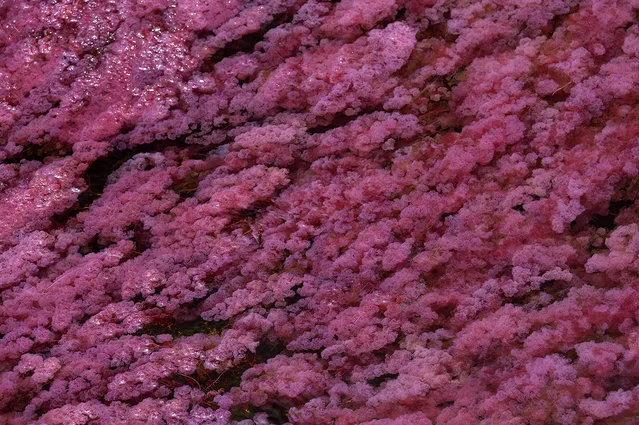
Macarenia clavigera the endemic aquatic plant that grows in the Cano Cristales River in Colombia becomes red when the water level drops, and when the current is not too strong. These pigments protect it from solar radiation. (Photo by Olivier Grunewald)
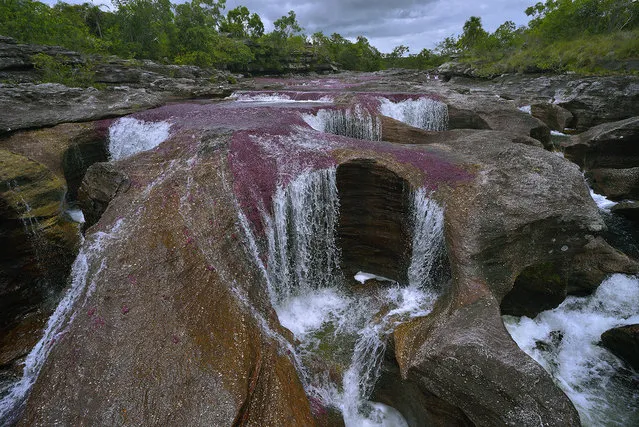
The Cano Cristales River dug these giants kettles baptized Los Ochos in old Precambrian rocks of 1200 million years of the Sierra de la Macarena in Colombia. (Photo by Olivier Grunewald)
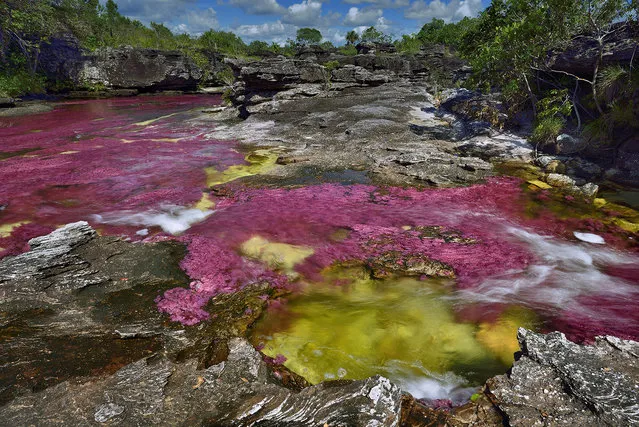
Cano Cristales is the “River of Five Colors” when aquatic plants that grow in its waters become red and when the Sun plays with water, yellow sand, and blue sky. (Photo by Olivier Grunewald)
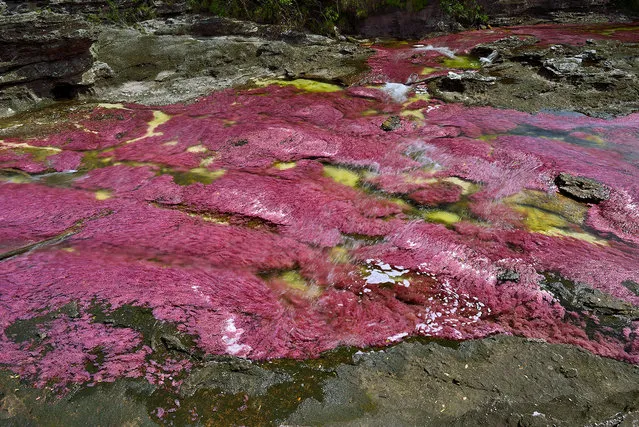
Cano Cristales is the “River of Five Colors” when aquatic plants that grow in its waters become red and when the Sun plays with water, yellow sand, and blue sky. (Photo by Olivier Grunewald)
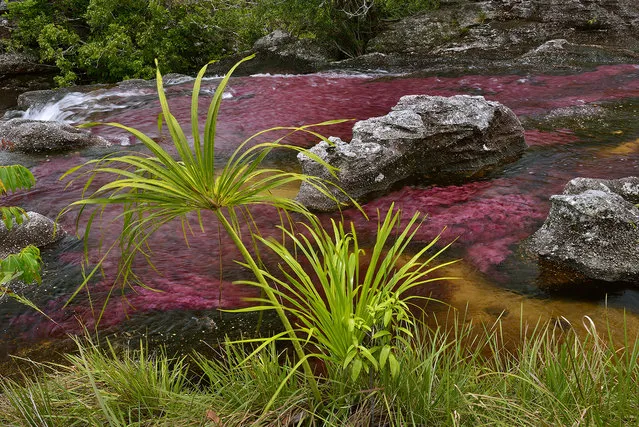
At the end of the rainy season, in August, when the water level finally decrease the Cano Cristales River in the Sierra de la Macarena in Colombia, becomes covered with a bright pink endemic aquatic plant, Macarenia Clavigera. (Photo by Olivier Grunewald)
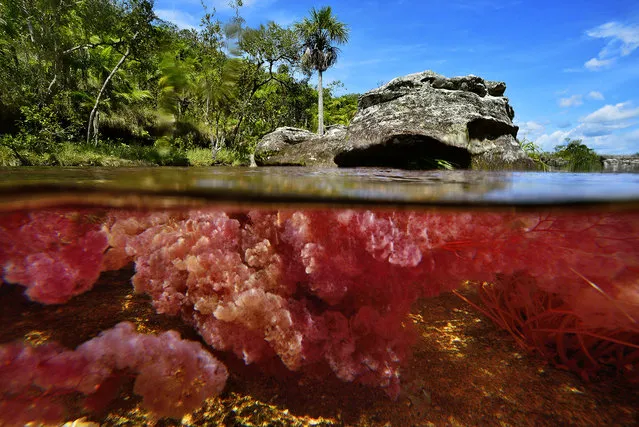
Macarenia clavigera the endemic aquatic plant that grows under the surface of the Cano Cristales River in Colombia is distinguished by it red stem firmly hang on the rock, its look like cotton floating at the surface. (Photo by Olivier Grunewald)
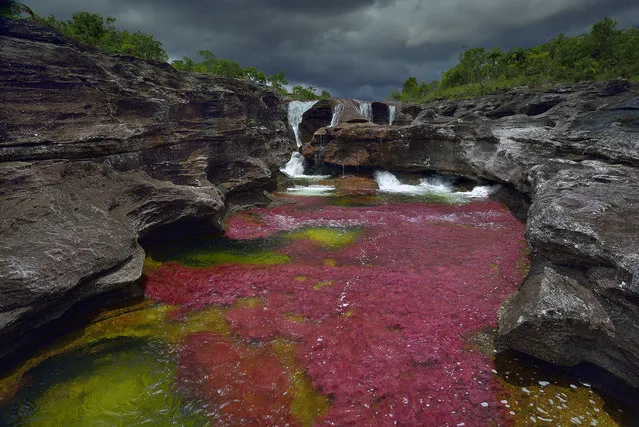
A waterfall is seen at the end of the rainy season, in August, when the water level finally decreases, in the Cano Cristales RIver in the Sierra de la Macarena in Colombia. It has become covered with a bright pink endemic aquatic plant, Macarenia Clavigera. (Photo by Olivier Grunewald)
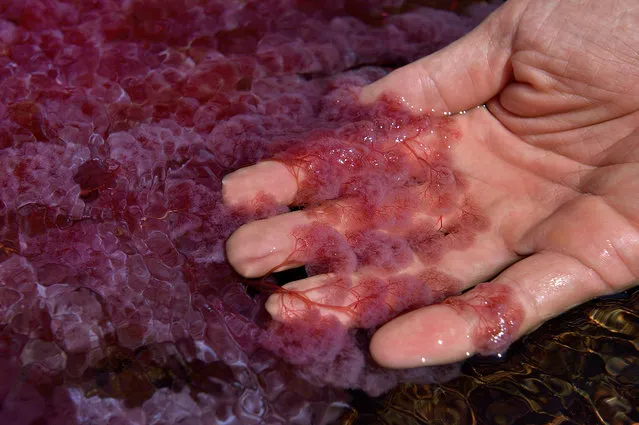
Macarenia clavigera the endemic aquatic plant that grows in the Cano Cristales River in Colombia becomes red when the water level drops, and when the current is not too strong. These pigments protect it from solar radiation. (Photo by Olivier Grunewald)
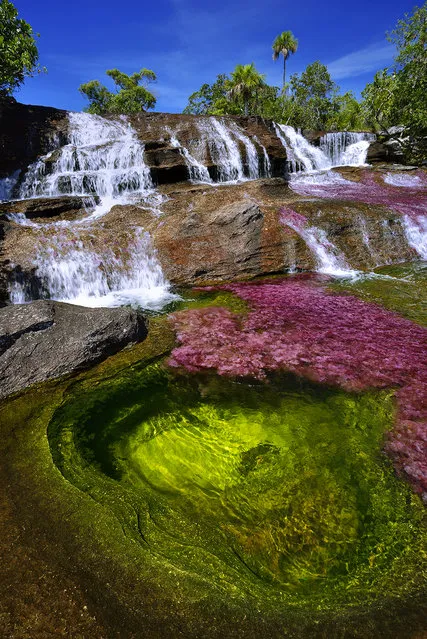
A waterfall is seen at the end of the rainy season, in August, when the water level finally decreases, in the Cano Cristales RIver in the Sierra de la Macarena in Colombia. It has become covered with a bright pink endemic aquatic plant, Macarenia Clavigera. (Photo by Olivier Grunewald)
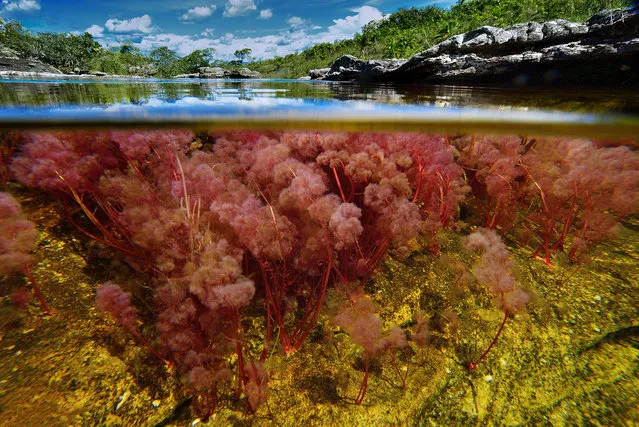
Macarenia clavigera the endemic aquatic plant that grows under the surface of the Cano Cristales River in Colombia is distinguished by it red stem firmly hang on the rock, its look like cotton floating at the surface. (Photo by Olivier Grunewald)
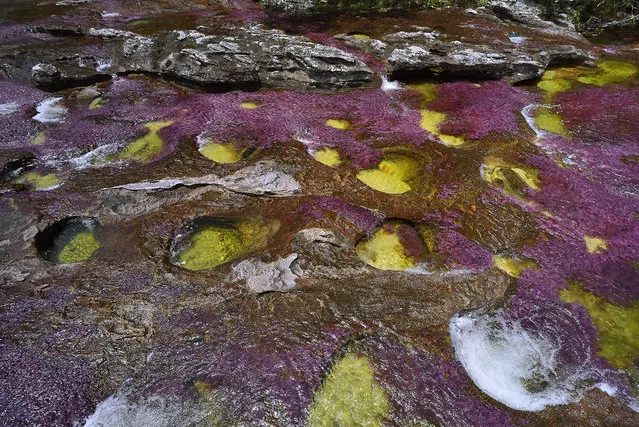
The Cano Cristales River dug these giants kettles baptized Los Ochos in old Precambrian rocks of 1200 million years of the Sierra de la Macarena in Colombia. (Photo by Olivier Grunewald)
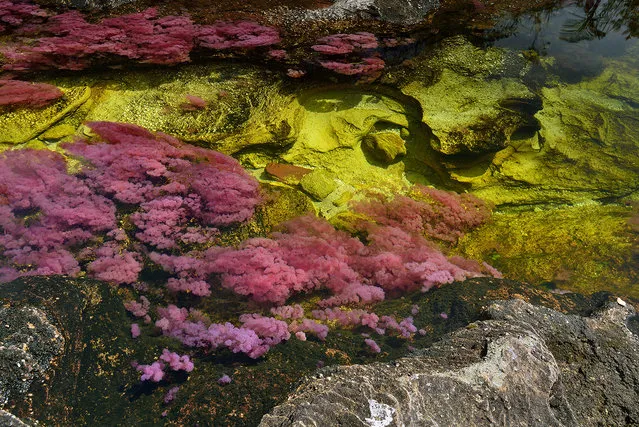
Cano Cristales is the “River of Five Colors” when aquatic plants that grow in its waters become red and when the Sun plays with water, yellow sand, and blue sky. (Photo by Olivier Grunewald)
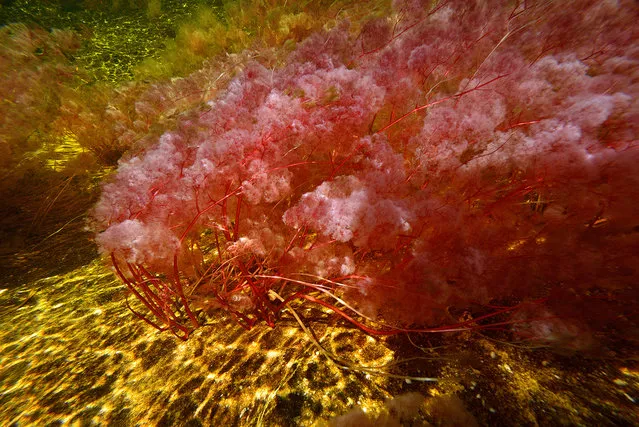
Macarenia clavigera the endemic aquatic plant that grows under the surface of the Cano Cristales River in Colombia is distinguished by it red stem firmly hang on the rock, its look like cotton floating at the surface. (Photo by Olivier Grunewald)
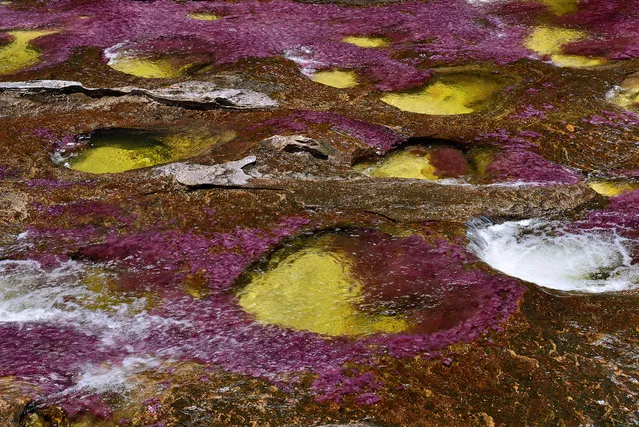
The Cano Cristales River dug these giants kettles baptized Los Ochos in old Precambrian rocks of 1200 million years of the Sierra de la Macarena in Colombia. (Photo by Olivier Grunewald)
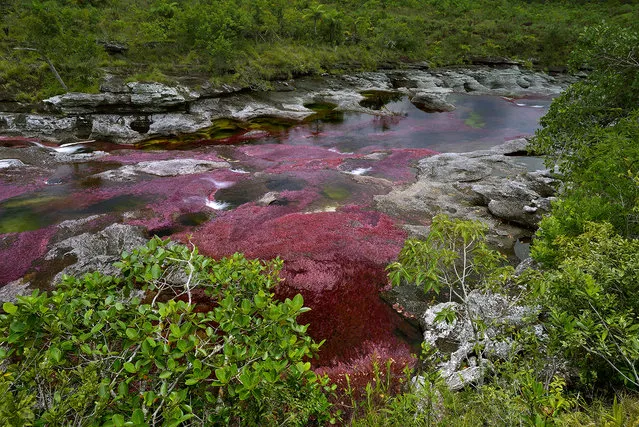
At the end of the rainy season, in August, when the water level finally decreases the Cano Cristales RIver in the Sierra de la Macarena in Colombia, becomes covered with a bright pink endemic aquatic plant, Macarenia Clavigera. (Photo by Olivier Grunewald)
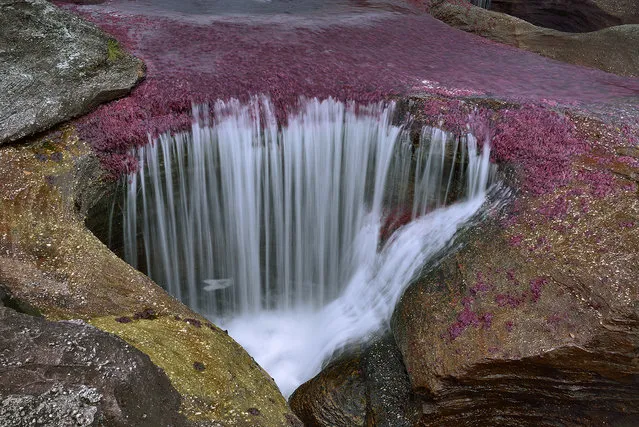
Water falls into a pit or “kettle” at the end of the rainy season, in August, when the water level finally decreases, in the Cano Cristales RIver in the Sierra de la Macarena in Colombia. It has become covered with a bright pink endemic aquatic plant, Macarenia Clavigera. (Photo by Olivier Grunewald)
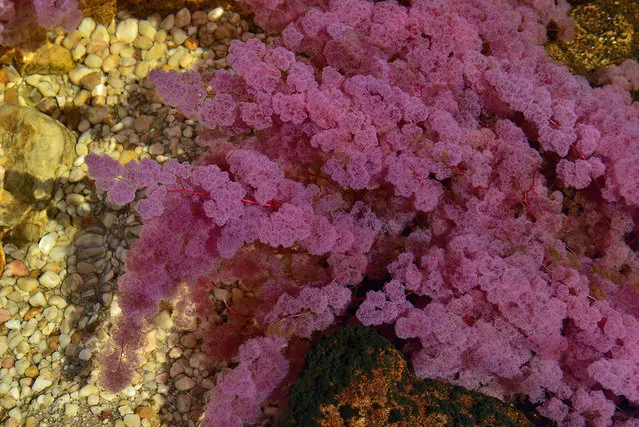
Macarenia clavigera, the endemic aquatic plant that grows in the Cano Cristales RIver in Colombia becomes red when the water level drops, and when the current is not too strong. These pigments protect it from solar radiation. (Photo by Olivier Grunewald)
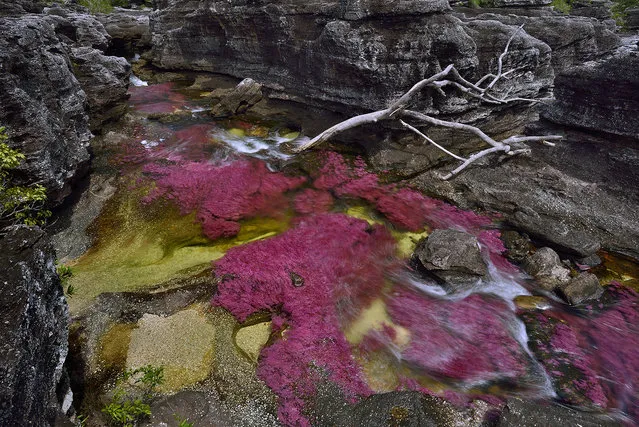
An overview of the Cano Cristales RIver in the Sierra de la Macarena in Colombia, covered with a bright pink endemic aquatic plant, Macarenia Clavigera. (Photo by Olivier Grunewald)
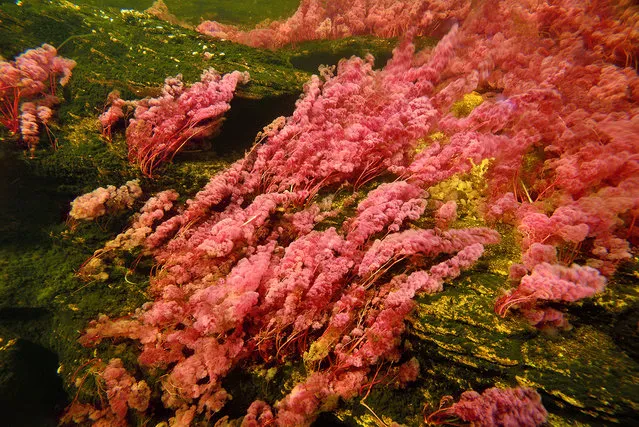
Macarenia clavigera the endemic aquatic plant that grows under the surface of the Cano Cristales River in Colombia is distinguished by it red stem firmly hang on the rock, its look like cotton floating at the surface. (Photo by Olivier Grunewald)
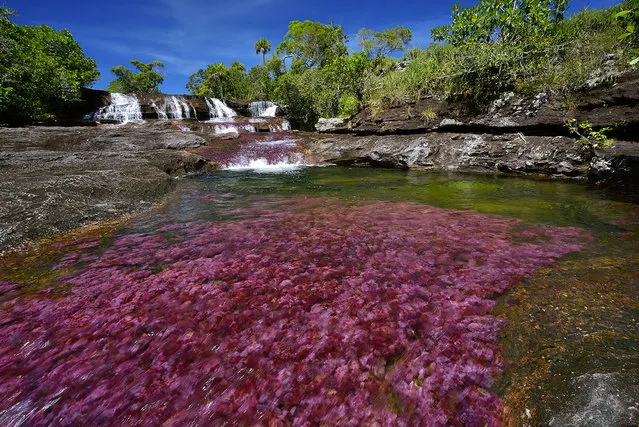
A waterfall is seen in the distance on the Cano Cristales RIver in the Sierra de la Macarena in Colombia. It has become covered with a bright pink endemic aquatic plant, Macarenia Clavigera. (Photo by Olivier Grunewald)
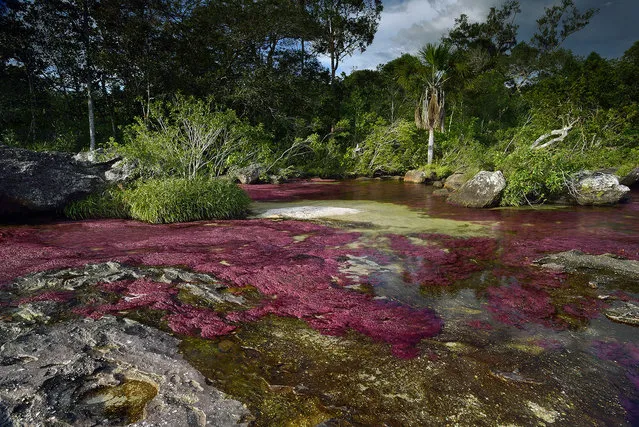
At the end of the rainy season, in August, when the water level finally decrease the Cano Cristales River in the Sierra de la Macarena in Colombia, becomes covered with a bright pink endemic aquatic plant, Macarenia Clavigera. (Photo by Olivier Grunewald)
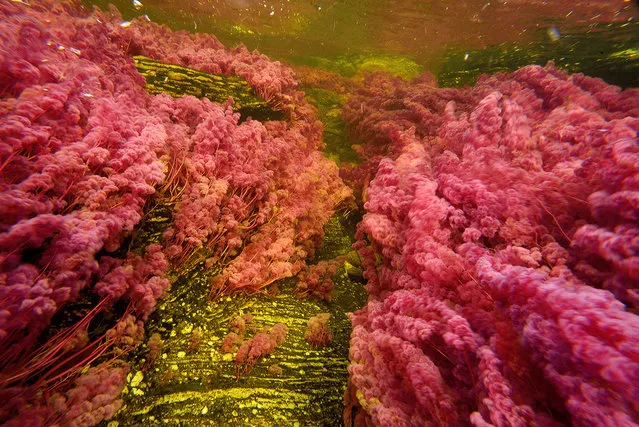
Macarenia clavigera the endemic aquatic plant that grows under the surface of the Cano Cristales River in Colombia is distinguished by it red stem firmly hang on the rock, its look like cotton floating at the surface. (Photo by Olivier Grunewald)
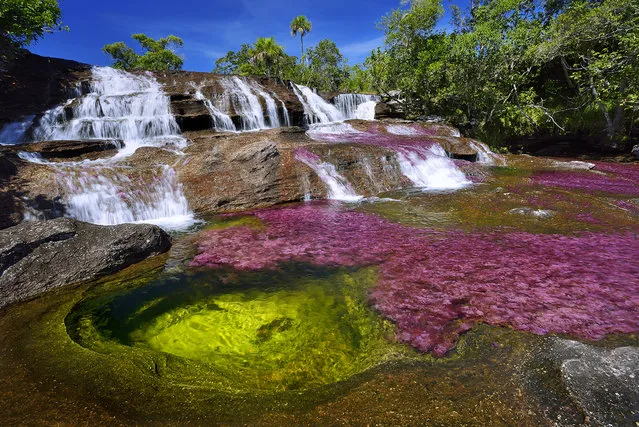
A waterfall is seen at the end of the rainy season, in August, when the water level finally decreases, in the Cano Cristales RIver in the Sierra de la Macarena in Colombia. It has become covered with a bright pink endemic aquatic plant, Macarenia Clavigera. (Photo by Olivier Grunewald)
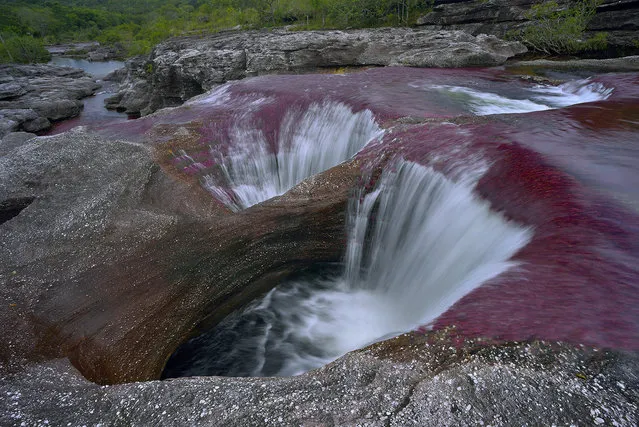
The Cano Cristales River dug these giants kettles baptized Los Ochos in old Precambrian rocks of 1200 million years of the Sierra de la Macarena in Colombia. (Photo by Olivier Grunewald)
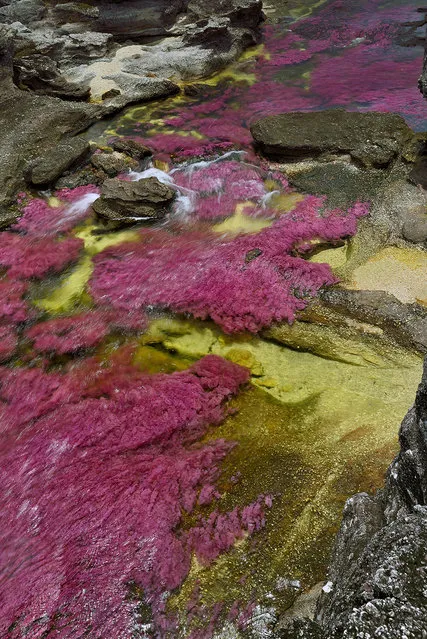
An overview of the Cano Cristales RIver in the Sierra de la Macarena in Colombia, covered with a bright pink endemic aquatic plant, Macarenia Clavigera. (Photo by Olivier Grunewald)
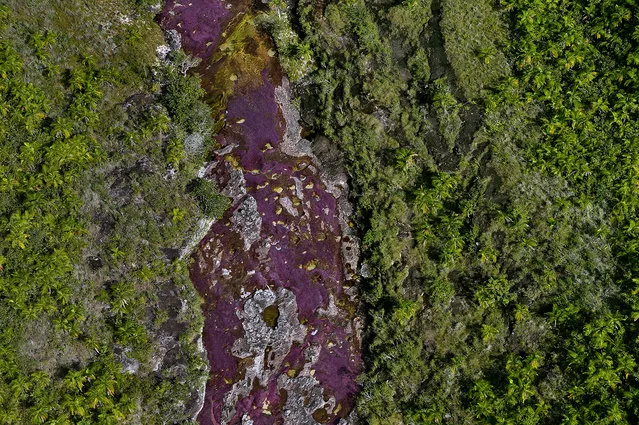
An overhead view of the Cano Cristales RIver in the Sierra de la Macarena in Colombia. (Photo by Olivier Grunewald)
25 Mar 2014 15:15:00,
post received
0 comments
